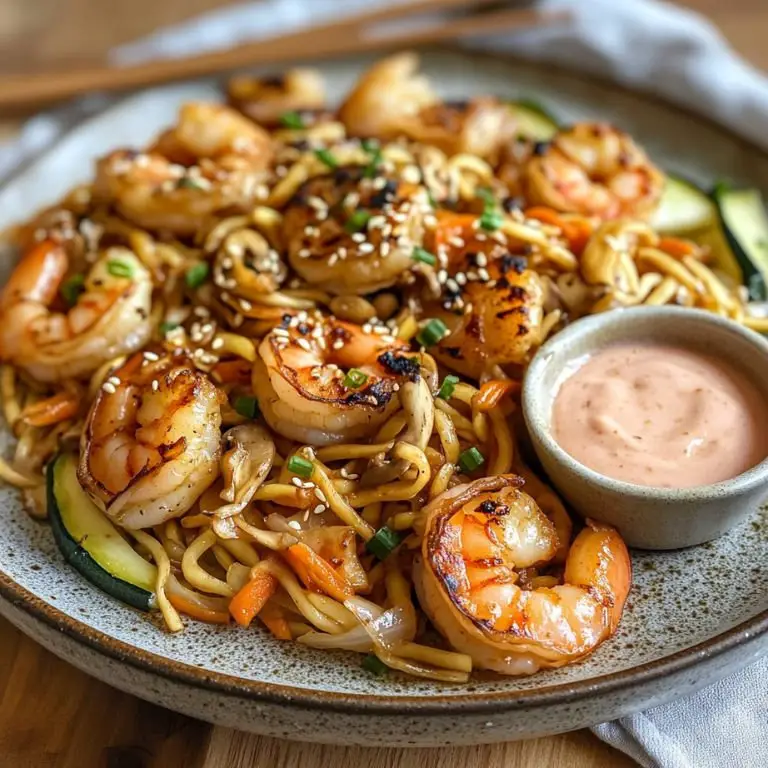If you’ve ever sat around a teppanyaki grill, mesmerized by flying shrimp tails, sizzling garlic butter, and the chef’s clanging spatula skills, you know hibachi meals are more than food—they’re an experience. But guess what? You can recreate that magic in your own kitchen with this Hibachi Shrimp Noodles with Yum Yum Sauce recipe. This isn’t just one of those easy hibachi recipes—it’s packed with juicy shrimp, tender hibachi-style noodles, and a creamy, tangy sauce that brings the whole dish together. It’s perfect for weeknight dinners or impressing guests with your Japanese steakhouse skills—minus the flaming onion volcano.
Hibachi Shrimp Noodles with Yum Yum Sauce
Prep Time 15 minutes mins
Cook Time 15 minutes mins
Total Time 30 minutes mins
Course Main Course
Cuisine American, Japanese
Large skillet or wok (a wok is ideal, but any wide-bottomed skillet will work for this hibachi at home recipe)
saucepan (for boiling noodles)
Mixing bowl (for the Yum Yum sauce)
Tongs or spatula
For the Hibachi Shrimp Noodles
- 1 lb large shrimp peeled and deveined
- 8 oz lo mein noodles or spaghetti as an alternative
- 2 tbsp sesame oil
- 1 tbsp butter
- 3 cloves garlic minced
- 1 small onion thinly sliced
- 1 cup zucchini halved and sliced (a nod to classic hibachi vegetables recipe)
- 1 cup mushrooms sliced
- 1/2 cup carrots julienned
- 1/4 cup soy sauce
- 1 tbsp oyster sauce
- 1 tbsp mirin or rice vinegar
- Salt and pepper to taste
For the Yum Yum Sauce
- 1/2 cup mayonnaise
- 1 tbsp ketchup
- 1 tsp garlic powder
- 1 tsp onion powder
- 1 tbsp melted butter
- 1 tsp sugar
- 1 tbsp rice vinegar
- 1 –2 tbsp water to thin
Cook the noodles
Boil the lo mein noodles according to package directions. Drain, toss with a drizzle of sesame oil to keep them from sticking, and set aside.
Make the Yum Yum sauce
In a bowl, whisk together mayo, ketchup, garlic powder, onion powder, sugar, vinegar, melted butter, and a little water to get your desired consistency. Set aside or refrigerate until ready to serve.
Sauté the veggies
Heat the wok over medium-high heat. Add a tablespoon of sesame oil and toss in the onions, zucchini, carrots, and mushrooms. Sauté until they’re tender but still crisp, about 4–5 minutes. Remove from the pan and set aside.
Cook the shrimp
In the same wok, add a pat of butter. Toss in the shrimp and cook until pink and just opaque, about 2 minutes per side. Season lightly with salt and pepper.
Bring it all together
Add the noodles back into the pan with the shrimp. Pour in soy sauce, oyster sauce, and mirin. Stir-fry everything together until the noodles are glossy and well-coated. Toss the cooked veggies back in and combine thoroughly.
Serve with sauce
Plate up the noodles and shrimp, then drizzle or dollop with the Yum Yum sauce. Serve extra on the side—trust me, everyone will want more.
Pairings
Want the full hibachi-at-home vibe? Serve this dish with a side of miso soup or a crisp cucumber salad. A scoop of steamed white rice also makes a great base if you want to stretch the meal. For drinks, green tea or a cold Japanese beer like Sapporo or Asahi fits the theme perfectly. For a fusion twist, try pairing with a side of lumpia if you're into Filipino food—it makes an unexpected but delicious combo.
FAQs
1. Can I use other proteins?
Absolutely! This recipe works great with chicken or steak. Hibachi noodles with chicken is a super popular variation—just sub in bite-sized chicken thigh or breast pieces, seared until golden.
2. What kind of noodles should I use?
Lo mein noodles are ideal, but you can also use yakisoba, ramen noodles, or even spaghetti in a pinch. The key is getting that stir-fry texture—bouncy but not mushy.
3. Is this considered a healthy hibachi recipe?
Compared to restaurant versions, yes! Using moderate oil, lean shrimp, and loading up on vegetables makes this a lighter option. You can also go low-sodium on soy sauce and use Greek yogurt in the Yum Yum sauce if you want to cut calories.
4. What’s the secret to great hibachi sauce?
Balance. A good hibachi sauce recipe (like Yum Yum) has creamy, tangy, and umami notes. For an extra kick, stir in a little sriracha or wasabi. You can also make a ginger soy dipping sauce as another option.
5. Can I meal prep this?
Totally. It reheats well and actually tastes better the next day as the flavors settle. Keep the sauce separate until serving to keep the noodles from getting soggy.
